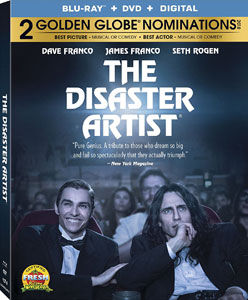“The Disaster Artist” (2017), now available for home viewing, starts with various actors marveling over the horrible 2003 movie “The Room” and the fact that people still talk about it years later. They also raise the central question behind the phenomenon: Who is Tommy Wiseau, the man who saw this debacle from concept to finished film? Two hours later, you will have had a great time watching “The Disaster Artist,” but disappointingly, you won’t have the answer.
James Franco, who also directs, threads the needle of playing a unique individual with many off-putting traits without making his performance off-putting. Self-centered but not dangerous (we think), Tommy agrees to a request from Greg Sestero (James’ brother Dave) to read scenes together after an acting class where Greg is boring and Tommy is insanely over-the-top. Tommy speaks with a vaguely European accent but insists he’s from New Orleans, he’s clearly older than Greg but claims to be the same age, and he has apartments in San Francisco and Los Angeles but no apparent source of income. He gets particularly brusque when Greg asks him about his life.
Objectively, Tommy is the giver in the friendship, as he invites Greg to stay rent-free at his L.A. apartment while they pursue their acting dreams. But it’s hard to see how Greg could be intellectually stimulated by this friend whose passion for acting and moviemaking is absurdly out of proportion with his abilities, and who only wants to talk about his dreams in the most abstract fashion. Soon, when Tommy launches his self-funded production of “The Room,” the cast and crew must constantly weight the horrible experience – creatively and physically – with the fact that they are being well paid.
Written by Scott Neustadter and Michael H. Weber (“500 Days of Summer,” “The Spectacular Now”), “The Disaster Artist” originates from a book by Sestero, who – despite revealing Tommy’s weirdness to the world – is still good friends with Wiseau. The bulk of the film chronicles the production of “The Room” in can’t-tear-your-eyes-away fashion.
Tommy buys both film and digital cameras, which is wasteful and pointless. The cameras require different lighting, and it’d make much more sense to transfer from one format to another after the fact. He builds an alley set right next to a real alley. Yet he pinches pennies in other areas, such as not providing air conditioning or water for the cast and crew. It’s fun to watch Seth Rogen as the script supervisor, Paul Scheer as the production assistant, and Ari Graynor as the lead actress react to the absurdities.
Off set, Tommy behaves no better, as he pulls out his headshot and resume for an uber-producer (Judd Apatow) at a restaurant – something that Hollywood 101 students could tell you is simply not done. Apatow tells him he won’t make it in this business in a million years. “What about after that?” Tommy responds without irony, channeling “Dumb and Dumber’s” Lloyd Christmas.

Apatow says you need talent plus luck to succeed to Hollywood. Tommy proves him wrong: Without a shred of talent, but by a tremendously lucky stroke of perfect timing, he finds success. Invitees laugh and cheer at the vanity project’s premiere – an event entirely funded by Tommy, natch – and with Greg’s urging, he embraces it as a dark comedy (but fools no one into believing this was the intention). Word spreads. After all the special screenings through the years, it has made back its $6 million budget and then some. Today, “The Room” rates a 3.6 on IMBD, suggesting that it’s not a so-bad-it’s-good film, but something rarer: A movie beloved for its earnest badness.
After this so-crazy-it-has-to-be-true yarn, though, I wanted to know Tommy’s nationality and age and income source and psychological diagnosis. “The Disaster Artist” doesn’t answer these questions, or even try. The web tells me Wiseau was born in 1955 in Poland, although the source of his wealth remains a mystery. Keeping that a secret is almost more remarkable than “The Room” phenomenon. Hints about his condition – such as Tommy’s revelation that he was once in a bad car accident – are peppered so sparsely I’m not sure they’re intended as clues.
“The Disaster Artist” is an entertaining ride, but it’s ultimately a mystery without a solution.

